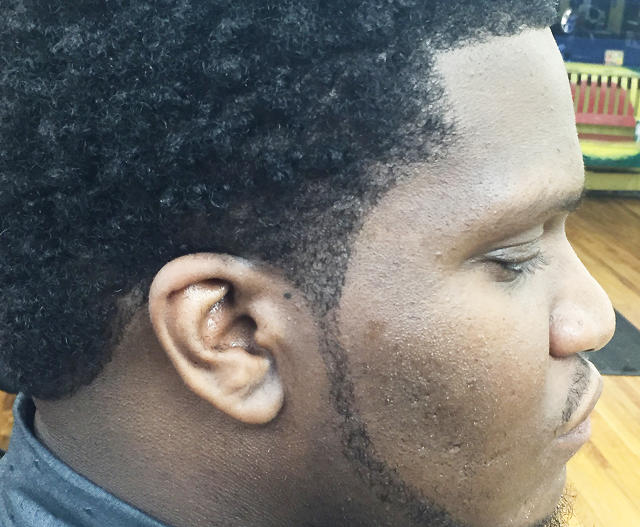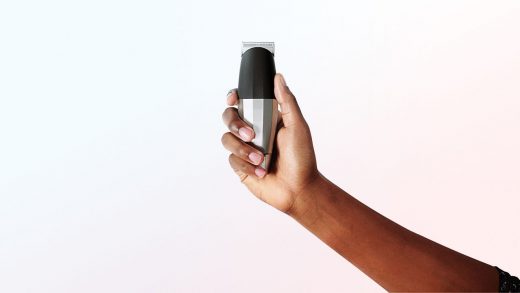Here’s What Happened When I Used The Bevel Trimmer, Tristan Walker’s New Product
I have a complicated relationship with electric trimmers.
I typically use the devices to tidy up the edges of my hair line, including my beard and mustache. (The little that I can get to grow, that is.) But here’s the thing: I’ve purchased the same pair of trimmers—the T-Outliner by Andis—at least three times over the past eight years or so. Crazy, I know. But even though the T-Outliner overheats (not fun on the skin), requires a screwdriver to adjust or change the blade, and has no cordless option, it is powerful and delivers a precise cut. When I’ve tried alternatives at comparable price points ($50-$60), none have even come close. Until now.
Ever since Tristan Walker, founder and CEO of the health and beauty startup Walker & Company Brands (which aims to solve problems in the space for underserved customer demographics), revealed to me in his much-discussed Fast Company feature story two years ago that he was developing an electric trimmer, I’ve been giddily (and probably annoyingly) peppering him with questions about the product’s release.
Walker: “We’re launching our products in Target!”
Me: “Cool! When’s the trimmer shipping?”
Walker: “J.J., Nas just mentioned us in his new single!”
Me: “Nice! Where the trimmers at, tho?”
The company finally started shipping the pre-ordered Bevel Trimmer in July—barely past the company’s cushiony “Spring 2016” promise to customers—and since I’ve been in the market for a new trimmer for quite some time, I was excited to get my hands on it.
The trimmer marks two important milestones for Walker & Company: It’s their second product offering—a subscription-based shaving system, which combats razor irritation, was the first—and manufacturing it required electrical engineering expertise. Critics have questioned whether or not Walker & Co., which is based in Palo Alto, qualifies as a tech startup. The Bevel Trimmer should answer that question; it is mostly superior to its rivals.
It was shepherded from concept to finished product by Mir Anwar and Mari Sheibley, Walker & Company’s director of operations and creative director, respectively, along with some help from the design firm Bone & Black (whose founder, Martin Bone, currently serves as creative director at Eileen Fisher and previously worked at Philips’s men’s grooming unit). The Bevel Trimmer costs $199 and is marketed as a vast improvement over its rivals.
Whereas some cordless trimmers lose power when unplugged, the Bevel Trimmer claims zero power loss. Its blades have a special coating that repels oil and water to prevent residue buildup—I’m too embarrassed to show you my Andis blade—and it also snaps off to reveal a “Bevel Dial” (patent pending) underneath, which can simply be rotated left or right to adjust sharpness—no toolkit required.
Since the trimmer is marketed as a “pro-sumer” device, for both the average Joe and his barber, I decided to first let my ear-lowerer, Lester Greene at De Lux Hair Gallery in Fort Greene, Brooklyn, give me a shape-up using the product. Greene has been cutting my hair for a little more than two years now, and we often discuss new haircare products and techniques I should try—along with work, socio-economic issues, relationships, and all the other sundry topics overheard in primarilyblack barbershops. It has always been obvious that Walker knows this familial relationship well: Walker & Co.’s online lifestyle publication, Bevel Code, features profiles on Kanye’s and President Obama’s barbers, as well as a “Find Your Barber” platform for readers looking for Bevel-approved styles. This relationship is a crucial cross-promotional tool for selling Bevel Trimmer units. For example, I first started using the Andis T-Outliner because a former barber did.

Greene, 42, had never heard of Tristan Walker or Bevel—but as we unboxed it, a younger, 30-ish barber visiting from next door ran over with wide eyes: “Oh, is that that new Bevel?!?” We flipped open the lid of the box and were thanked (via a hand-signed note) from Walker and the musician Nas, a company investor, for our patronage, and were greeted with the words “Welcome To The Bevel Fam” in big white letters under the lid. Though the paper wrapper with the boring product details / certifications was a bit tough to remove, the actual product casing was a delight to open. There was the slow-open, air-tight effect that is most associated with the packaging of Apple products.
Right away, Lester loved the design of the trimmer, and started to resemble a kid with a new toy, twirling it in his hands, admiring the grip provided by the faceted surface. Lester said he was in the process of finally going cordless, and was intrigued. “It’s futuristic,” he said, as he directed me over to the chair. “It’s very modern, compared to the basic design we’ve been accustomed to for the past 30 years.”
He continued to shower the trimmer with compliments as he started in on my hairline, fantasizing about how much time he could save with the snap-off blade. He switched between using the cord and going cordless, and said he couldn’t detect any power loss (though the device was a little loud, either way).
Then I noticed that he kept switching back to his standard trimmer, made by Wahl. “Is it giving a close cut?” I asked him. “Uhh…not the sharpest,” he replied with hesitation, and said that he was having to do twice as much work with the Bevel Trimmer than with his old faithful. After a few more minutes I heard him say to the Bevel in his thick Trinidadian accent, “Yeah, I had enough of you,” and he finished the rest of the shape-up with his old standby.

I was a bit surprised—how could my barber not like the Bevel Trimmer, which had just gotten a ringing endorsement from DJ Khaled on Snapchat? (Major key!) I left the barbershop puzzled, and it wasn’t until I reached out to the company did I realize the issue: The Bevel Dial, which my barber had tinkered with before commencing the cut, wasn’t turned all the way up to the sharpest setting. (In barber speak, this is called “zero-gap.” Some people prefer duller settings to accommodate different types of designs, or soft or sensitive skin.) In Lester’s defense, the knob on the dial is a tad small and hard to turn—neither his hands or mine are exactly Donald Trump-sized—and it’s easy to imagine that he thought the knob was turned completely to the right.

Aside from that design tweak, though, Walker & Co. should also consider a more hands-on selling approach for first-time Bevel Trimmer users, since it’s so drastically different from other competitive products (neither Lester nor I even thought to check the Bevel Dial as he complained about its non-sharpness). Though Walker & Co. is still a small company, it has already demonstrated that it understand and appreciates the value of “doing things that don’t scale,” as the Silicon Valley adage goes. Whether this takes the form of in-person sales reps or producing how-to videos, barbers and consumers won’t be able to unlock the Bevel Trimmer’s superiority if it feels too foreign. Another adage that applies: Show, don’t tell. (That also means ditch the stubborn paper wrapper, since much of the info on the wrapper is already in a little insert inside the box, and make the instructions more visual)

A few days after my trip to the barbershop with the Bevel Trimmer—and after the company rep helped me get the setting right—I decided to freshen up Lester’s work. The trimmer was still charged, the strokes were quick and clean, and my forehead was not cauterized. And my Andis T-Outliner? Finally, in the trash.
Fast Company , Read Full Story
(50)



